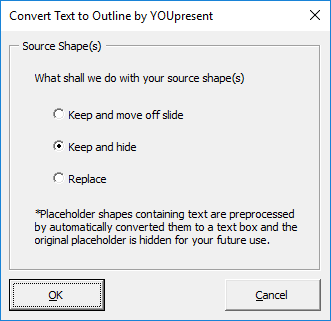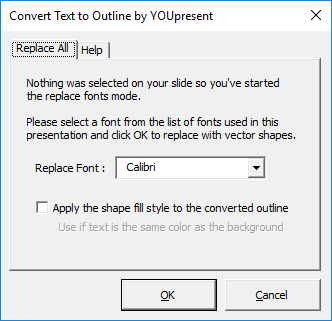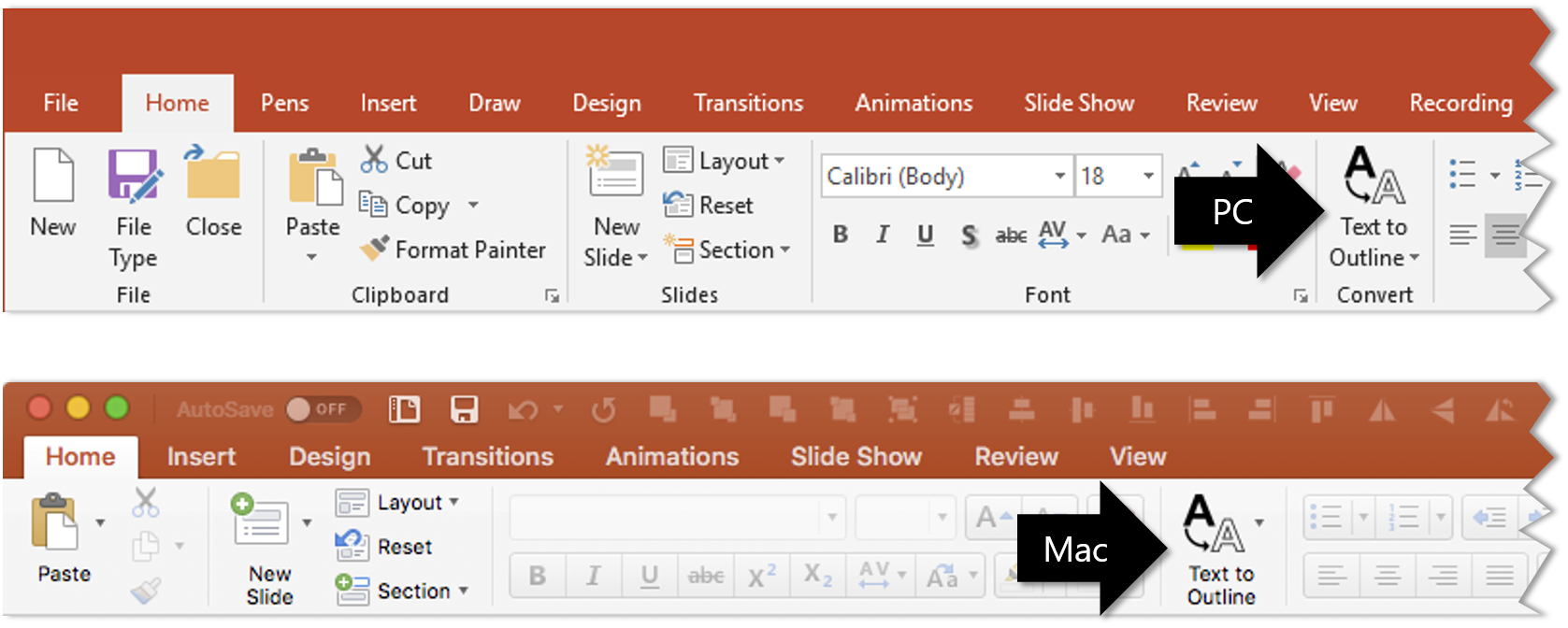FREE - Text to Outline add-in for PowerPoint
now works with Windows and Mac versions of PowerPoint 2016Picture Your Text
PowerPoint is a formidable tool for today’s creative content authors. The array of formatting and effects tools is simply stunning compared with early incarnations of the World’s favourite presentation platform.
But there are some things you might find you want to do and can’t.
Text is a great example. Since PowerPoint 2007 it’s been possible to edit many aspects of text such as filling it with complex gradients, changing outline colors and weight, and adding effects such as shadow, reflection and glow to name just a few.
One thing you can’t do is convert text to an outline like you can in Adobe Illustrator.
Why would you want to do this? Here’s a couple of reasons:
1. Create masks
Most text is filled with an opaque color, gradient, pattern, texture or picture that makes it stand out from the background:

But what if you wanted to do the inverse by making the background stand out through the text?
To do this, you need to convert text to an outline and then do a couple of extra things to ‘subtract’ it from the semi-transparent rectangular black shape.

2. Stretch text
PowerPoint provides some Transform tools to distort text but what if you just want to stretch text independently in the horizontal or vertical direction?

3. Apply Soft Edges to text
If you’re already familiar with soft edges you’ll know that you can apply this effect to shapes to make them ‘float’ more naturally on the slide but you can’t apply soft edges to text. At least not until now!

4. Distribute presentations with non-system fonts
Finally, you may just want to do something as simple as make sure the recipient of your presentation receives and sees it the way you intended. PowerPoint includes a feature for embedding fonts in presentations which is very useful but sometimes, this is an overkill if there’s just one word in a special font that you’ve used. Converting that little bit of text to a vector shape is a much more efficient way to guarantee portability while at the same time preventing the text from being edited.
What does Text to Outline do?
Once you’ve installed the add-in, you simply select a shape containing text and click the convert button or select nothing to process all text across a presentation. If you choose to, your original text is kept and a new shape outline of your text is created. Because they both look the same until you start editing the text, we’ve selected to show the shape points on the example converted text below.
Text prior to conversion (rectangle shape with text inside it):

Post conversion (freeform shape that represents the original text):

And don’t worry, your original text will be kept if you choose so that you have an editable version of the original for use at a later date:

Replace All Text Mode
From version 1.1 we added the ability to process text across an entire presentation. The feature behaves in a similar way to the Replace Fonts feature in PowerPoint. To use this mode, you make sure that nothing is selected and then click the Text to Outline button in the ribbon as normal. You then get asked to specify which of the fonts that are in use within your presentation should be processed:

Text to Outline will then look at all shapes on all slides across your presentation and process them if it can. There are a few shape types that cannot be processed:
- Groups
- Shapes that contain multiple fonts
NEW! From version 1.5, placeholders are now supported but they need to be converted to text boxes first. Your original placeholder is maintained and we just simply hide it on the slide for you.
Why is it free?
We love PowerPoint. And sometimes, we just like to give something back. That’s the first reason and no, we don’t spy on you or mine any personal data, period. The second reason is that because the way PowerPoint works and more importantly the available programming tools folks like us use to create add-ins, conversions are not 100% accurate. For example, you may see small deviations in reflections and we can’t transfer picture fills from your text to the newly created outline. Supporting this complexity is costly so we decided to give the add-in away without any support. Finally, we dropped a couple of hints into the add-in about other paid-for products that you may find interesting. If you like it, why not share our love and share this page using the links below?
Compatibility
Text to Outline is compatible with the following:
Windows
10 (x86 and x64)
8 (x86 and x64)
7 (x86 and x64)
OSX
10.10 (Yosemite) and higher
PowerPoint (PC)
2016 (32 bit and 64 bit)
2013 (32 bit and 64 bit)
2010* (32 bit and 64 bit)
2007*
PowerPoint:mac
2016
* the add-in will install with these versions of PowerPoint but you will not have access to the main conversion feature as Microsoft didn’t develop the required functionality until Office 2013.
As of version 1.53, Text to Outline is supported on PowerPoint:mac 2016 with the same features as the PC version.
So how do I get Text to Outline?
Well, because PowerPoint continues to improve, the first thing to note is that the main feature works with PC versions of PowerPoint 2013 (Office 365) , 2016 and later. The Windows version of the add-in will install in earlier versions such as 2010 and 2007 but you won’t get access to the full functionality.
Next, just click your preferred download method below and install it as you would with any other Windows application. For Mac, the add-in is installed manually but is pretty simple.
Once installed, a single Text to Outline button will be added to the Home tab in PowerPoint.
To start using it, select a text box, placeholder or shape containing text on your slide and click the button to convert it.
Windows
Windows
Mac
Update History
V1.54 Build 24APR2018 12:49
Changes
- Tweak : if the source shape is kept, its name is now maintained and the new shape prefixed with “[T2O] “
- Tweak : in Keep & Hide mode, the source shape no longer moves off of the slide (its position is maintained).
- Tweak : a help tip icon has been added to the mode window to show how to unhide the source shape(s).
V1.53 Build 23APR2018 15:20
Changes
- New clearer icon added with support for Mac Retina screens. Thank you to Nolan Haims Creative for providing this.
V1.52 Build 19APR2018 14:07
Changes
- Mac version (for PowerPoint:mac 2016 only) now supports the same features as the PC version.
V1.5 Build 15SEP2016 11:15
V1.51 Build 21MAR2018 10:07
Changes
- First version for PowerPoint:mac 2016 (limited features : doesn’t support conversion of full presentation yet)
V1.5 Build 15SEP2016 11:15
Changes
- Added support for placeholders
- Added an option to hide the source shape(s)
V1.4 Build 19AUG2016 11:30
Changes
- Added support for Windows 10 and PowerPoint 2016 (PC only)
- Updated links from old GMARK and i-present.co.uk domains to youpresent.co.uk
- Upgraded the digital certificate to use the latest SHA256 certificate scheme (required by Microsoft)
Older versions
V1.3 Build 19AUG2014 15:25
- Various bug fixes
V1.2 Build 27FEB2014 09:15
- Various bug fixes
V1.1
- Added the ability to process multiple text shapes across an entire presentation.

